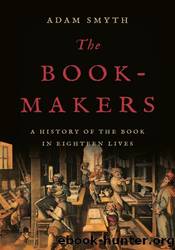The Book-Makers by Adam Smyth

Author:Adam Smyth [Smyth, Adam]
Language: eng
Format: epub
Published: 2024-05-28T00:00:00+00:00
Nicolas-Louis Robert was a bright child, born in Paris in 1761 to an upper-middle-class family. He was nicknamed âthe philosopherâ at school, although itâs hard to know, at this historical distance, quite the balance of mockery, affection, and respect this moniker may have implied. His years after school had a meandering quality: Robert tried and failed to join the army (he was too slight), and endured some unhappy times toiling as a clerk, increasingly guilty that he was a profitless drain on his mother and father. But then Robert successfully enrolled in the regiment of the Grenoble Artillery in April 1780, and fifteen months later was sent with the Metz Artillery to Santo Domingo in what we now call the Dominican Republic, where he worked as a gun-layer â aiming the artillery â and acquired a reputation for calm and bravery during battle with the English in the American War of Independence. So far, none of this is very papery, but after the army, Robert obtained work as a proofreader for the celebrated printer and publisher Pierre-François Didot the younger (1731â93). His master soon noted Robertâs capacities, and recommended him to his son, Saint-Léger Didot, who was running the family paper mill at Essonnes; the production of paper for assignats, or banknotes, was a dominant part of the business. Robert was put in charge of accounts. He flourished; married; had a daughter. These were happy years, and Robertâs thus far only latent talent for invention began to find expression. As he walked the floor of the paper mill, Robertâs imagination crunched down on a problem like the hammers stamping macerated rags. The problem he saw was the 300 workmen. In Robertâs eyes, they constituted a labour force too aware of its desirable skills, who brought acrimony and argument and clogged up what might somehow â reimagined â be a leaner process of production. Robert started to envision a better version of the Essonnes paper mill without these irksome bodies. An environment of machines â one can almost hear the sighs-to-come of William Morris and Thomas Cobden-Sanderson who attempted to reverse an industrialised process of book-making (Chapter 9). This is an important point to stress: the seeds of the machine production of paper lay not in any ideal of democratising paper consumption and encouraging literacy or in any other kind of cultural enrichment; working in the Revolutionary context immediately after 1789, Robertâs machine-vision had its origins in a kind of business misanthropy, in a desire to eliminate people. If we look today at the magnificent illustrations that accompany Diderot and dâAlembertâs account of pre-mechanisation paper mills in their 1751â66 Encyclopédie (here), what strikes us first is the vision of sparsely peopled cleanliness and order. These workspaces are full of a quiet and entirely unrepresentative calm: there is almost no one around, and the workers that are present are silently at one with the process of production. At most, a gentle whistling. The figures are dwarfed by huge close-ups of the tools
Download
This site does not store any files on its server. We only index and link to content provided by other sites. Please contact the content providers to delete copyright contents if any and email us, we'll remove relevant links or contents immediately.
| Booksellers & Bookselling | General |
| History of Books |
4 3 2 1: A Novel by Paul Auster(12333)
The handmaid's tale by Margaret Atwood(7711)
Giovanni's Room by James Baldwin(7256)
Asking the Right Questions: A Guide to Critical Thinking by M. Neil Browne & Stuart M. Keeley(5712)
Big Magic: Creative Living Beyond Fear by Elizabeth Gilbert(5681)
Ego Is the Enemy by Ryan Holiday(5351)
The Body: A Guide for Occupants by Bill Bryson(5033)
On Writing A Memoir of the Craft by Stephen King(4893)
Ken Follett - World without end by Ken Follett(4686)
Adulting by Kelly Williams Brown(4536)
Bluets by Maggie Nelson(4515)
Eat That Frog! by Brian Tracy(4484)
Guilty Pleasures by Laurell K Hamilton(4395)
The Poetry of Pablo Neruda by Pablo Neruda(4066)
Alive: The Story of the Andes Survivors by Piers Paul Read(3998)
White Noise - A Novel by Don DeLillo(3982)
Fingerprints of the Gods by Graham Hancock(3966)
The Book of Joy by Dalai Lama(3947)
The Bookshop by Penelope Fitzgerald(3812)
